Your Cart is Empty
8-4 Mon.-Sat. / 9-4 Sun.
FREE DELIVERY OVER $80. Flat $10 for $40-80.
8-4 Mon.-Sat. / 9-4 Sun.
FREE DELIVERY OVER $80. Flat $10 for $40-80.
8-4 Mon.-Sat. / 9-4 Sun.
FREE DELIVERY OVER $80. Flat $10 for $40-80.
Our Coffee Collection
Core -represents our signature espresso and rich morning coffees, the tried and true crowd-pleasers.
Fringe - represents those brighter coffees that spark curiosity and speak to the adventurous.
The Coffee Club
Our Coffee Collection
Core -represents our signature espresso and rich morning coffees, the tried and true crowd-pleasers.
Fringe - represents those brighter coffees that spark curiosity and speak to the adventurous.
The Coffee Club
Join Today!
April 27, 2021 3 min read
As we say goodbye to Kirinyaga from Kenya, we welcome Kabare which is from the same region as our previous Kenyan coffee! It is also a peaberry! Don't know what a peaberry is? Read down below to find out more about it!

Country: Kenya
Region: Kirinyaga County
Variety: SL28, SL34, Ruiru 11, and Batian
Altitude:1700-1900 masl
Process: Washed
Mt. Kenya, at the helm of Kenya’s Central Province, is the second tallest peak on the continent of Africa and a commanding natural presence. The mountain itself is a single point inside a vast and surreal thicket of ascending national forest and active game protection communities.
Kirinyaga county is certainly well-known among these central counties for its jammy, exuberant coffees. Kenya’s coffee is dominated by a cooperative system of production, whose members vote on representation, marketing and milling contracts for their coffee, as well as profit allocation.
Kabare is a Farmers’ Cooperative Society (FCS), which is the central management body for 11 different cooperatives in Kirinyaga County: Kiringa, Konyu, Karani, Kiangombe, Kaboyo, Mukure, Mukengeria, Kimandi, Kathata, Kiangothe, and Kiamiciri. Combined, these groups represent almost 10,000 farming households, whose land spans from nearby Kerugoya town all the way to the forest border at Mt. Kenya National Park.
Most part of Kenya continues to thoroughly wash and soak its coffees according to tradition. Kabare FCS are no different, sorting their pulped and fermented coffee into 4 different density grades with the use of fresh nearby water, and conditioning the moisture of each grade independently during drying, before transport to the mill.
Buy Kabare HereTypically, in a coffee cherry, two beans (technically seeds) grow inside one cherry. That is why part of the bean is flat on one side; to make room for two seeds in one cherry. With a peaberry, there is only one seed growing inside the cherry that's why the seed appears to be round with no flat surfaces.
They occur as a result of a natural mutation, or defect, inside a coffee cherry. Approximately 5-10% of a harvest consists of peaberries. Sometimes peaberries are sorted during the post-harvest process, they’ll either be separated by size using a sieve or, alternatively, sophisticated machinery which quickly sorts by weight and size. Kenya is one of the countries known for peaberries because their farms have the machines to find and separate them out from the normal seeds during the processing. This is how we get a importers advertising it as peaberry coffee.
For comparison we have the peaberry seeds (unroasted and roasted) and "normal" seeds (unroasted and roasted) pictured below. You can see that the peaberries are much smaller and rounder whereas the regular beans are larger and have a flat surface to them.
|
Peaberry Green |
Peaberry Roasted |
|
Normal Green |
Normal Coffee Roasted |
Some people consider peaberries to be superior and believe they taste better than regular beans. They say that peaberries are sweeter, lighter, and have more flavour because the one seed inside the cherry is getting all the nutrients from the whole cherry instead of normal seeds where they share it. Some say that it is just regular coffee and as long as it is treated with the highest care and quality, there is no difference.
